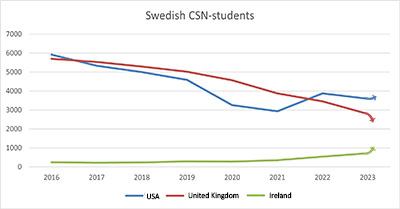Take a Bachelor’s Degree in the US
If you want to study at a college or university in the US for a longer period of time you usually take a Bachelor’s Degree. Here we answer all common questions.
Why take a Bachelor’s Degree in the US?
How to apply to a US university?
How many years is a Bachelor's Degree in the US?
How can you make your money last longer when you study in the US?
How to choose the right school and place of study?
Why take a Bachelor’s Degree in the US?
If you want to study in the US after you have graduated from High School you have four different options; take a Bachelor’s Degree, take 1-2 study abroad semesters, take a language course or a Master’s Degree if you already have a Bachelor’s Degree.
The US has some of the world’s most famous and high ranking universities. A degree from a US university can open many doors in your future career. Another reason to take your degree in the USA is their unique system with Majors and Minors, where you study one main subject (your major) at the same time as you can take one or two minors in other subjects of your choice. This way you can create a unique degree where you combine your main subject with a hobby or a matching subject.
If you want to work in the US, it helps to have a degree from a US university. If you take a Bachelor in the US you can stay and work in the same field on OPT in 1 year or 3 years if you have a STEM degree (Science, Technology, Engineering, and Mathematics). If you do well during your OPT, your employer might be able to help you get a work visa in the US after your OPT expires. Studies followed by working on OPT is your best chance to stay in the US for many years without getting a green card.
How to apply to a US university?
The US doesn’t have any central application system like UCAS in the UK. You usually apply directly on the university’s website. It is not so hard, just make sure to read their Admission Requirements and submit everything they ask for. This usually includes your High School Diploma in English, a TOEFL-test, proof of financing, a passport copy, etc. Many schools also demand an SAT-test when you apply to an Undergraduate program. Read more in our article how to apply to universities abroad.
How many years is a Bachelor's Degree in the US?
In Europe, a Bachelor’s Degree takes three years (180 ECTS-credits). However, in the US it takes four years (at least 120 US credits) to complete a Bachelor’s Degree.
The reason for this is that at American universities you take a core curriculum on top of your major and minor studies. This core curriculum consists of general subjects such as Mathematics and English, and you primarily take them during your first year in college. This year can therefore sometimes be quite easy for European students since we have already taken many of those classes in High School. Therefore some American Universities give European students some credits from high school.
How much does it cost?
One of the drawbacks of studying in the US is the tuition fees which probably are the highest in the world. The tuition fee varies from about $9000 a year at Community Colleges to over $50000/year at some of the highest ranking universities. Public universities in the US currently charge about $25500 per year.
Below we will look at different ways to reduce the costs.
How can you make your money last longer when you study in the US?
You need a lot of money to take a Bachelor’s Degree in the US. Here is some advice on how you can keep the costs down:
- Take the first two years at a Community College and transfer to a university for the last two years. This way you get the same Bachelor’s Degree as if you had studied all four years at the university, but the cost will be much lower. It is easier to get accepted at Community Colleges, and their tuition fee is usually only around $9000/year which is less than 40% of the costs at a public university. Some Community Colleges like Seattle Central College also offer full Bachelor Degrees so you can take all four years at a lower cost.
- Apply for scholarships! In the US a high price equals status so the better ranking a school is, the higher their tuition fee will be. Since the schools collect so much money, they also have a lot of money to give back, and few students end up paying the list price since it is quite easy to get a scholarship that reduces your tuition fee. High ranking institutions like Harvard often have generous financial aid programmes for students who need them. At these schools the big challenge is to get accepted. However, it is very hard to get a full scholarship that covers all your costs on undergraduate level unless you are very good at an attractive sport like basketball. So you will need your own money to study in the US. Read more about scholarships for studying abroad. Please note that we cannot help you to get a full scholarship!
Read more in our article how much does it cost to study abroad.
How to choose the right school and place of study?
No school is right for everyone. If you want to keep your costs down, we recommend that you avoid the big cities and mainstream destinations such as New York, Los Angeles, and San Francisco. These locations are much pricier and more competitive than smaller and less well-known cities. If you are interested in San Francisco you can for example study at Lincoln University in Oakland. Their tuition fees are low, and the living costs are much lower than in San Francisco even though it only takes 15 minutes to go there by train or underground. Another good option is Northampton Community College in Bethlehem Pennsylvania, a nice student town within a couple of hours of New York, Philadelphia, and Washington.
If you choose a school with few students from your country, you will have a better chance of getting a scholarship since schools value a good nationality mix.
If you plan to work in the US, you had better choose a school with a big campus since the student visa usually restricts you to working on campus.






















